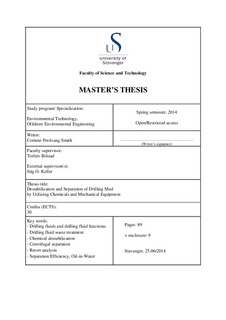| dc.contributor.author | Fredvang Smith, Corinne | |
| dc.date.accessioned | 2014-12-17T11:49:39Z | |
| dc.date.available | 2014-12-17T11:49:39Z | |
| dc.date.issued | 2014-06-25 | |
| dc.identifier.uri | http://hdl.handle.net/11250/227609 | |
| dc.description | Master's thesis in Environmental technology | nb_NO |
| dc.description.abstract | The research of this thesis was aimed to test new chemical mixtures for drilling fluid waste treatment and optimize them for different type of oil-based drilling muds. The research included two steps: pre-screening and main experiment. Pre-screening included identification and selection of the most efficient chemical mixtures on various industrial oil-base mud samples, as well as definition of optimum centrifugation conditions. Main experiment included determination of the most efficient conditions such as temperature and dosage of the selected chemical mixtures in order to destabilize chosen drilling muds down to clear 3-phase condition. During main experiment, oil-based muds were made into lab slop-muds to be more representative as mud waste. First destabilization of drilling slop-mud was done by adding small dosage of the chemical mixture to the drilling mud; then mechanical separation was done by a lab centrifuge; expecting to get clear 3-phase separation (oil, water and solid phases).
Decrease of viscosity of the mud samples was done by increasing operating temperature in some of the samples. Lower viscosity had significant improvement on the separation process as it provided better conditions during centrifugation and higher water recovery. Centrifugation parameters such as g-force and retention time were also evaluated. The results indicated that increase on g-force had dramatic effect on higher water recovery percentage, while retention time did not proof to be a considerable parameter in this work. Dosage of the chemical mixtures was another main factor, providing satisfying results during the separation process. By increasing the concentration of chemical mixtures phase separation was enhanced after centrifugation.
The main experiment resulted in successful destabilization and clear 3-phase separation on different oil-base slop-muds by MudSplit001, MudSplit003 and Mudsplit005. Mudsplit001 and Mudsplit005 concluded to be most effective chemicals with respect to dosing. Representative samples, giving satisfying result at lowest possible dosing, were analyzed for separation efficiency. Oil- and solids phases were analyzed by retort analysis, giving fractions of contaminants in the phases. The retort analysis method provided proper understanding on the content of the different phases. GC- Fid analysis by Intertek Westlab on decanted water phases showed low content of oil in the samples. | nb_NO |
| dc.language.iso | eng | nb_NO |
| dc.publisher | University of Stavanger, Norway | nb_NO |
| dc.relation.ispartofseries | Masteroppgave/UIS-TN-IMN/2014; | |
| dc.subject | environmental technology | nb_NO |
| dc.subject | teknisk miljøvern | nb_NO |
| dc.subject | drilling fluid | nb_NO |
| dc.subject | waste treatment | nb_NO |
| dc.title | Destabilization and separation of drilling mud by utilizing chemicals and mechanical equipment | nb_NO |
| dc.type | Master thesis | nb_NO |
| dc.subject.nsi | VDP::Technology: 500::Environmental engineering: 610 | nb_NO |
| dc.source.pagenumber | 89 (+ enclosure 9) | nb_NO |
